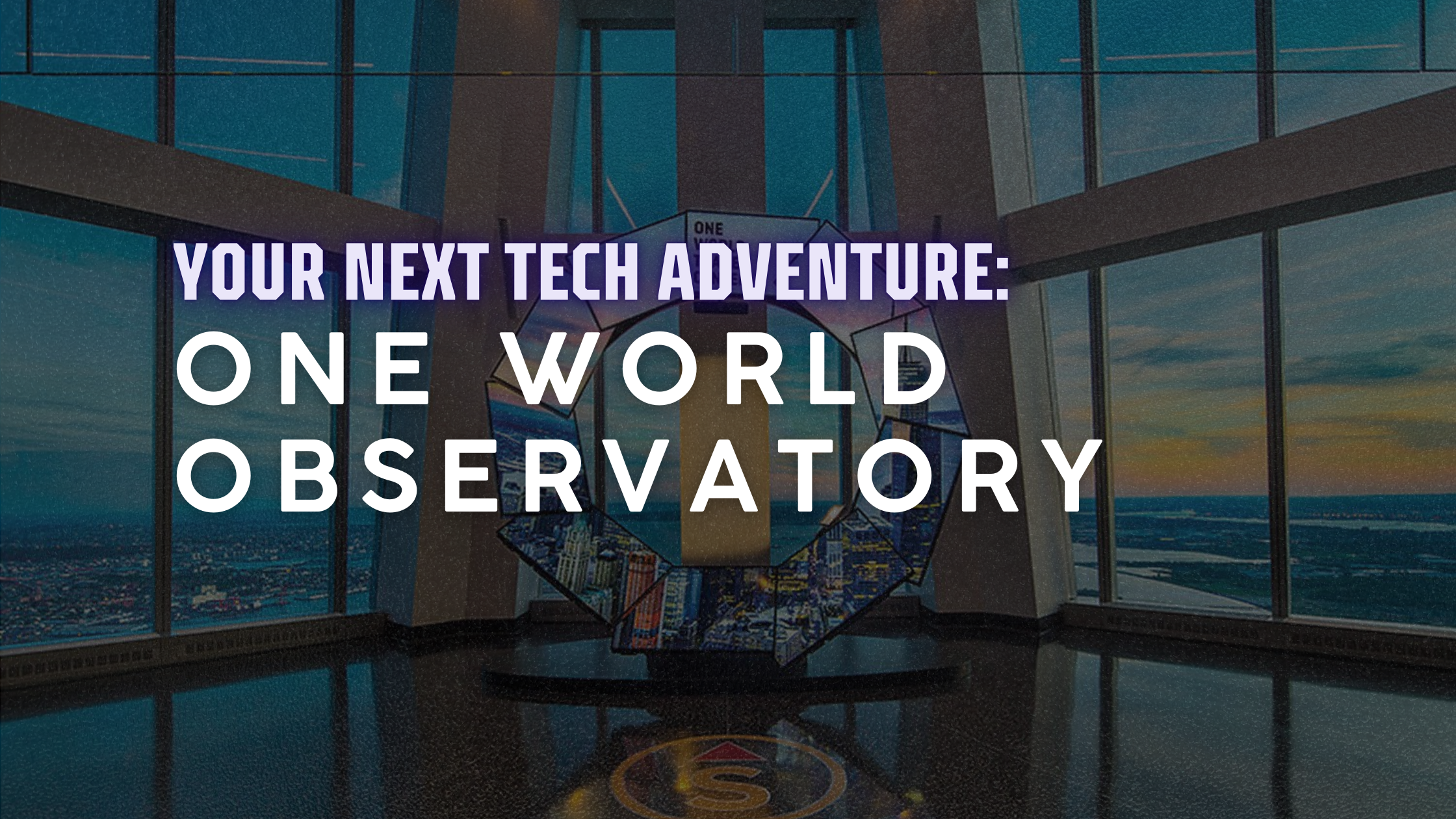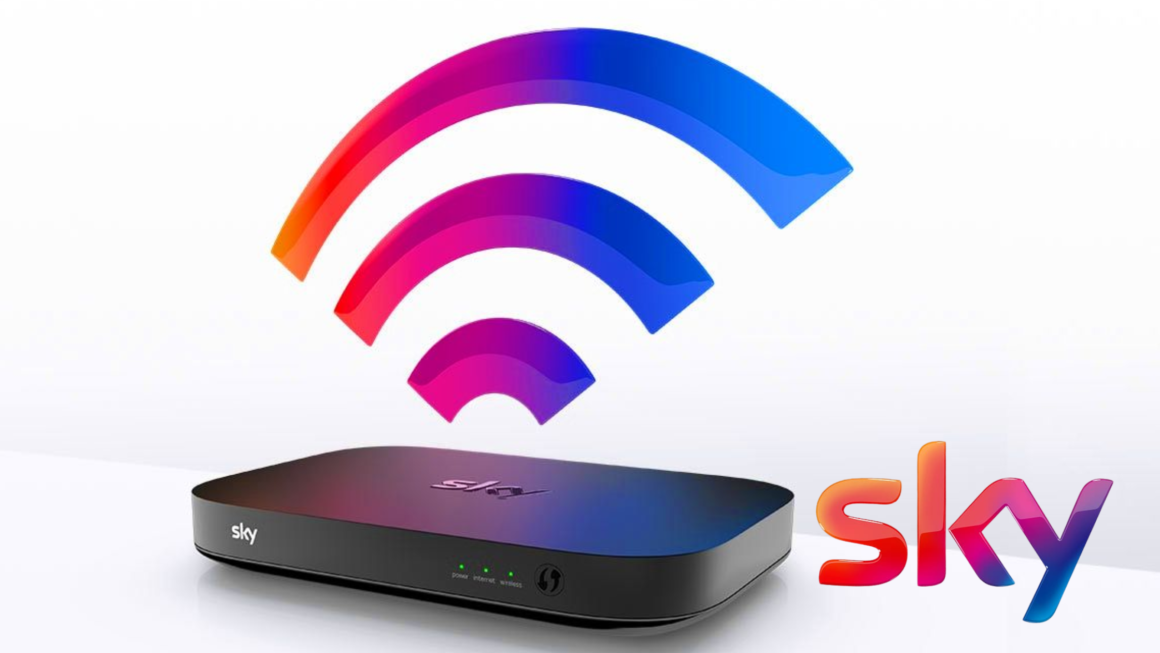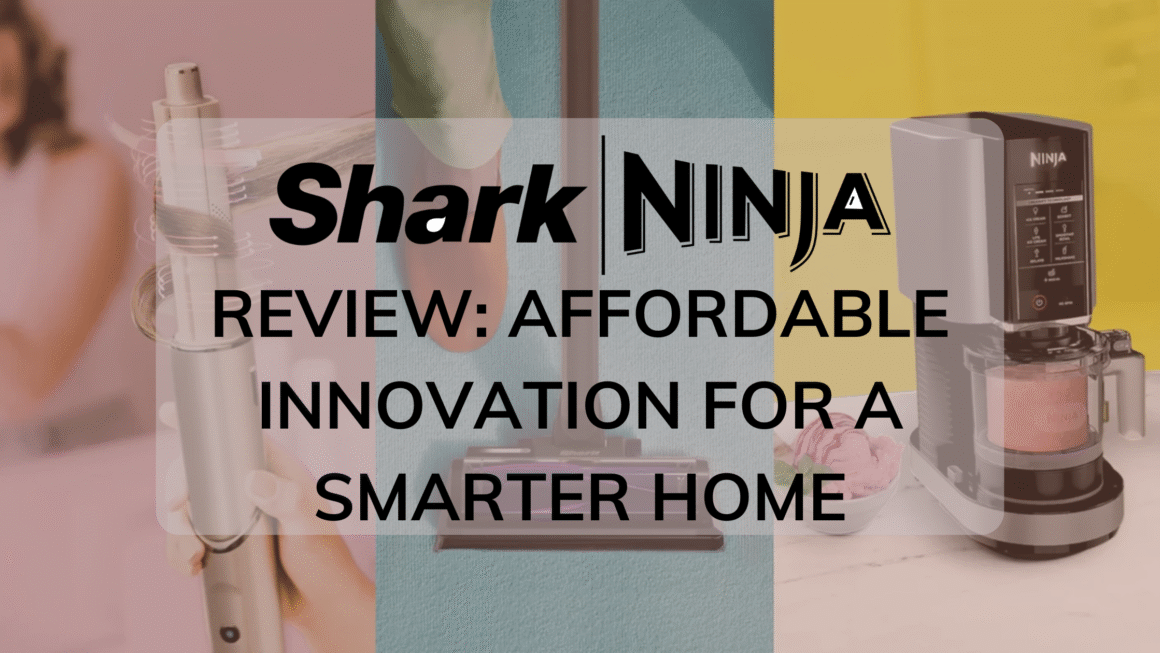There’s a specific moment—102 stories above Manhattan—when the skyline stretches endlessly and everything below fades into a pixelated cityscape. That moment happens at One World Observatory, and it’s nothing short of surreal.
But what makes this place unforgettable isn’t just the view. It’s the technology built into every inch of the experience. From the instant you step inside, you’re immersed in a digital journey that feels more like stepping into a live simulation of New York than a traditional sightseeing stop. Let’s take a closer look at how this sky-high destination fuses storytelling and innovation in ways you wouldn’t expect.
The Tech Behind the View
At One World Observatory, the experience starts before you even glimpse the skyline. Everything leading up to the view feels intentional and designed. Each element uses technology to engage, inform, and stir emotion. From the elevator ride to digital displays, you experience New York through innovation, not just observation.
SkyPod Elevators: A Time-Lapse in Seconds
SkyPod elevators travel 1,268 feet in just 47 seconds, making them among the fastest in the Western Hemisphere. Inside, wraparound LED screens display a digital time-lapse of Manhattan’s skyline development from the 1500s to today. You watch buildings rise, neighborhoods take shape, and landmarks appear with cinematic clarity. The ride feels smooth, immersive, and surprisingly emotional for an elevator trip. It’s a moving historical journey that happens entirely in motion.
See Forever Theater: Immersive Visual Storytelling
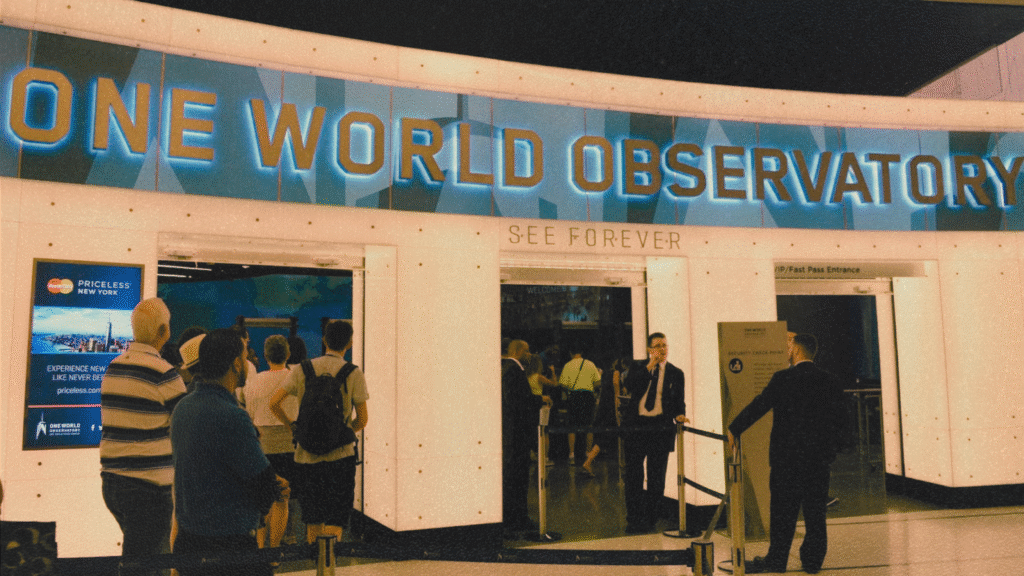
After the elevator ride, you step into the See Forever Theater, a curved cinema space with surround visuals and sound. A short film plays, filled with scenes of energy, people, and city life. The story moves quickly, capturing New York’s essence in light and motion. At the final moment, the screen lifts and reveals the skyline through glass. The transition is seamless and leaves many visitors stunned.
Digital Welcome Wall
As you continue, you encounter the Digital Welcome Wall—a massive screen that updates in real time using motion sensors and guest data. It displays “Welcome” in dozens of languages, matched to the visitors’ home regions. Each message flashes brightly, acknowledging different cultures and countries. It’s a warm, global touch powered by smart design. Visitors stop, take photos, and smile as their language appears on screen.
Interactive Features That Geek Out Your Trip
One World Observatory transforms observation into interaction. Rather than simply viewing New York from above, visitors are invited to explore it through cutting-edge tools and responsive displays. The experience is designed for curiosity—it responds to your movement, gestures, and attention. With every step, the city becomes more than a view; it becomes a living, digital story you can dive into.
City Pulse: Gesture-Controlled Exploration
At the heart of the observatory stands City Pulse—a circular, concierge-led installation that blends real-time storytelling with motion-sensing visuals. A live guide stands in the center and gestures to activate content on the 14-screen ring around them. Each screen responds instantly, revealing details about NYC’s boroughs, history, neighborhoods, and current events. You’ll see restaurants, landmarks, and even cultural festivals displayed with vivid graphics and up-to-date data. It feels like watching the city breathe in sync with your interest. This experience turns the guide into a conductor and the screen into an ever-shifting city portrait.
One World Explorer Tablets
Each visitor has the option to rent a One World Explorer tablet—an iPad-like device that uses augmented reality to identify over 40 landmarks from the observation deck. As you pan across the skyline with the tablet’s camera, the device overlays interactive labels, facts, and historical comparisons. The sleek interface provides a second, digital layer of the city. It’s intuitive, multilingual, and ideal for curious minds who want to go deeper.

Key features include:
- Identify landmarks with real-time AR tags and zoom capabilities
- Zoom into areas and access detailed info about boroughs, bridges, parks, and buildings
- View historical overlays that compare today’s skyline with how it looked decades ago
Interactive Exhibits & Smart Wayfinding
Throughout the space, digital integration continues with smart floor sensors and responsive exhibits. Pathways are subtly lit and change based on time of day and visitor flow, guiding you effortlessly toward new zones. Wall-mounted displays react to your presence, shifting content as you move closer or pause in front of them. Some zones include touchless information panels and panoramic screens that shift focus based on motion detection. This spatial awareness turns passive spaces into adaptive environments. Even walking between sections feels orchestrated through invisible design.
The Design and Engineering That Wows
Beyond aesthetics lies innovation and structural intelligence.
This building doesn’t just reach the sky—it stands for something. One World Observatory combines structural strength, symbolism, and smart design in every detail.
Sustainable and Resilient Design
Everything here is made to last, adapt, and keep people safe—without drawing attention to itself.
The steel frame can handle extreme pressure from wind or impact. Smart systems manage lighting, heat, and water without wasting resources. Emergency features are built into the structure, not added later.
- Dual stairwells allow faster, safer evacuations
- Backup power systems stay active during outages
- Glass panels help control indoor temperature naturally
It’s a building that plans ahead—even for things we hope never happen.
Symbolic Architecture Meets Smart Materials
This tower tells a story through numbers and shapes. The height—1,776 feet—marks a turning point in American history. The base forms a square that slowly shifts into eight triangle-shaped sides as it rises.
It’s not just art. It’s engineering.
- Blast-resistant glass reduces damage under high force
- Flexible steel adapts to shifts in weight or wind
- Treated surfaces help the building respond to temperature changes
Every material choice protects, performs, and reinforces the meaning behind the structure.
Data-Driven Storytelling at Its Finest
One World Observatory doesn’t just display information—it transforms data into something that moves you. It uses real-time feeds, interactive visuals, and personal voices to help you understand the city in new ways. You’re not just looking at buildings—you’re connecting with stories powered by sensors, algorithms, and real people.
Voices: Multimedia Journey of Resilience
This exhibit combines video interviews, motion graphics, and panoramic footage to tell a very human story. You’ll hear firsthand accounts from ironworkers, engineers, and survivors who shaped the tower’s history. Their voices guide a visual journey—overlaying maps, blueprints, and digital recreations onto their words. The entire wall around you shifts with every scene. Emotional tones, ambient sound, and animated sequences all work together to make it deeply personal. It’s not a lecture—it’s a layered, living tribute to resilience.
Real-Time City Insights
The city below isn’t frozen—it pulses with life. Digital panels in the observatory stream current data from across NYC. The screens update by the second, reflecting what’s happening across streets, bridges, and boroughs. It feels like looking into the city’s control center.
These feeds show:
- Traffic patterns across bridges, tunnels, and avenues
- Live weather systems forming above the skyline
- Subway activity and reroutes across borough lines
Each feed is mapped directly onto the skyline so you can match data to real buildings.
Digital Narratives That Evolve
No two visitors see the exact same story. The observatory’s smart panels adjust their content in real time. Motion sensors detect how long you pause, what area you face, and even the time of day. That means your experience adapts as you move. For example, if you linger near a screen showing Lower Manhattan, it reveals deeper layers—past events, building timelines, and cultural touchpoints. In the evening, displays shift to highlight lighting patterns and skyline reflections. It’s storytelling that changes with you.
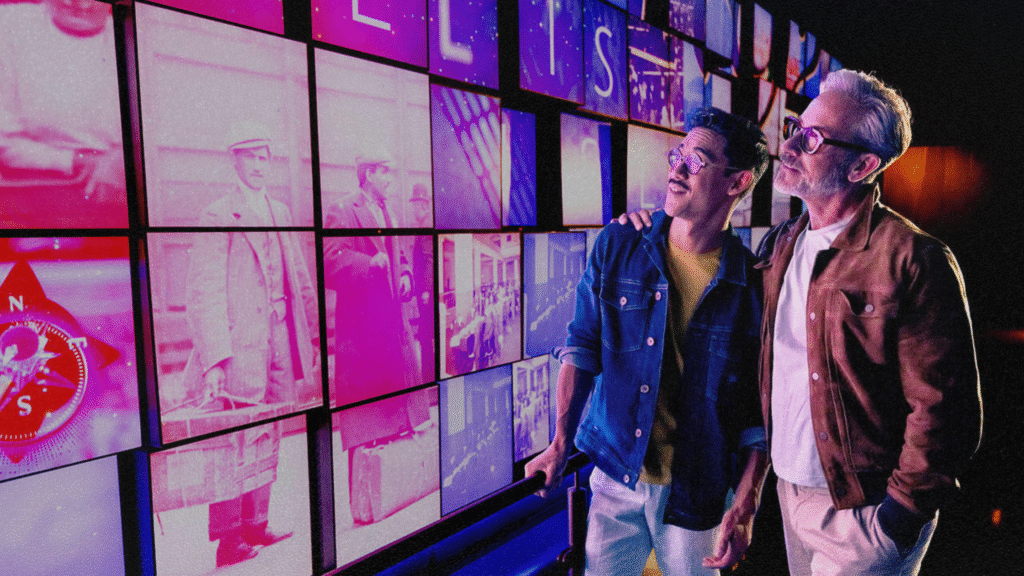
Merging Art with Technology
At One World Observatory, technology doesn’t hide behind the scenes—it steps into the spotlight. Every light, surface, and sound is designed to react, shift, and reflect your presence. You don’t just walk through the observatory—you move through a living piece of art. Each space responds to time, motion, and the energy of the city itself.
Light Mapping and Reactive Environments
As you move through certain areas, motion sensors trigger dynamic waves of color across walls and floors. The lighting changes based on your movement, adjusting tone and intensity without a single switch. During the day, the space feels calm and expansive. But as evening sets in, the colors deepen and slow, matching the city’s pace. These visual shifts are driven by real-time algorithms designed to make you feel present in every moment.
Architectural Light Art
The building’s surfaces do more than reflect light—they create it. Hidden LED systems embedded in ceilings and walls pulse gently throughout the day. These patterns don’t follow a loop—they react to live data, including time, traffic, and even weather. You might feel the tempo rise as the city below gets busier. Or you may notice a calming rhythm late in the evening. The light doesn’t just fill the space—it shapes its mood.
Projection-Mapped Moments
On holidays and special events, the observatory becomes a digital canvas. High-definition projections transform blank walls into scenes of celebration. Snow falls across glass during winter. Fireworks ripple through light during summer nights. These moments appear seamlessly, paired with subtle music and shifting ambience. They remind you that this isn’t just a building—it’s a space that listens, reflects, and celebrates with the city.
Practical Info for Tech Explorers
If you’re planning a visit, timing and tech add-ons can seriously level up your experience. These quick tips help you make the most of your trip, avoid crowds, and take advantage of everything One World Observatory offers—especially the features built with tech-savvy guests in mind.

Best Times for a Seamless Visit
- Visit on weekday mornings for fewer lines and quieter spaces
- Arrive during golden hour to capture the best lighting indoors and outside
- Avoid weekends and holidays to reduce wait time and crowd density
Tickets and Tech Packages
- Upgrade to an Explorer iPad for a full AR-enhanced skyline guide
- Book online in advance to access timed entry and bundled discounts
- Choose combo tickets that include a free digital souvenir photo
Accessibility and Connectivity
- Use free Wi-Fi available across all public areas of the observatory
- Access elevators and interactive screens designed for all mobility needs
- Explore AR-friendly areas tailored for guided access and support tools
Conclusion
One World Observatory isn’t just about seeing New York—it’s about experiencing it through the lens of technology, design, and emotion. From data-driven exhibits to responsive environments, every detail invites you to interact, learn, and feel something new. It’s a skyline adventure powered by innovation and human stories. If you’re building a tech-themed NYC trip, this stop belongs at the top of your list.

